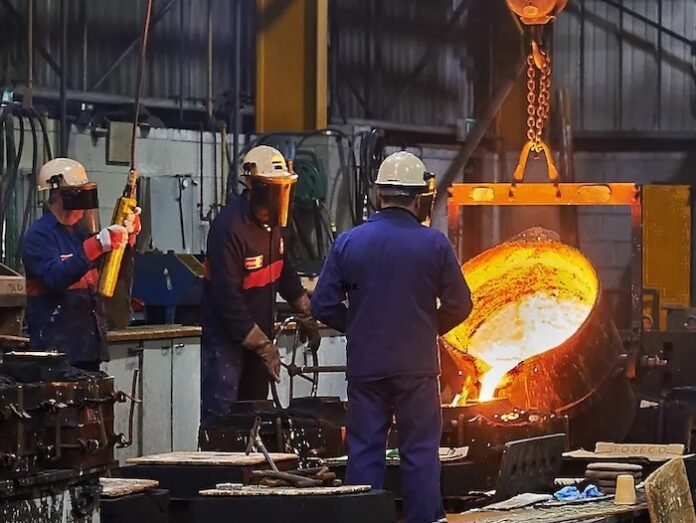In the first part of this story I wrote about the tariffs that the US has proposed and how this will affect the American market. So for this half I’m going to look at the impact on the rest of the world including China, as well as the UK and Europe.
For now, the main effect of the tariffs has been for US companies to pause some of their investment decisions. Pascal Juéry, CEO of Agfa explains, “In the first quarter in the US everybody wanted to delay so we see it has an impact because everybody wants stability. People think that if the rules are going to change then we are going to hold on. So the impact is more indirect than direct for us.” But he remains optimistic that the main effect will be delayed orders rather than reduced sales.
The different tariff rates also hand a competitive advantage to some non-US companies over others. Dimatix, for example, will benefit as a US manufacturer. But so too will Xaar, which manufactures its printheads in the UK with a 10 percent tariff, giving it an advantage over any of the Japanese printhead manufacturers, which are currently facing the threat of a further 24 percent reciprocal tariff.
Most vendors assume that they will be able to pass on the costs of the tariffs to their US customers. The other alternative would be to spread those costs across all their customers worldwide to avoid sudden price shocks to US customers. I put this to Frank Pennisi, CEO of EFI, at last month’s Fespa show and he replied, “We may have to pass on some price increases but we are still evaluating that.”
Trump has claimed that other countries are lining up to do deals with him. However, the US president does not have the authority to sign free-trade agreements without the approval of Congress. Instead Trump appears to be using his authority as president to simply set tariffs to wring concessions from other countries. This authority is itself subject to legal challenges. A future president will be able to change these tariffs immediately, undermining the value of any commitments that other countries make to the US.
British deal
Britain was one of the first countries to sign a trade deal with America, known as the US-UK Economic Prosperity deal. However, it quickly became apparent that the original ‘deal’ as announced on 8 May was more of a series of aspirations for further negotiations, with a first update announced on 16 June. This accepts America’s universal 10 percent levy on most UK goods. It also allows up to 100,000 cars at a 7.5 percent tariff, instead of a new 25 percent import tax imposed on all car imports earlier this year. This is stacked with an existing 2.5 percent levy, taking the levy for the UK to 10 percent. Automotive parts also carry the same 10 percent tariff. The UK currently imposes a 10 percent levy on US car imports which will remain in place. The deal also rescinds any tariffs on the majority of aerospace parts, which is mainly to protect US aircraft manufacturing supply chains.
However, the US will be able to export up to 1.4 billion litres of ethanol to the UK, without the existing 19 percent UK tariff. The UK has also set aside its 20 percent tariff on US beef imports and raised the quota to 13,000 tonnes. For now any US beef imports will need to meet UK food safety requirements though US trade negotiators have hinted that they will chip away at those standards.
For now, Britain is facing a 25 percent tariff on steel and aluminium with the possibility that this could be raised or lowered with further quotas still to be negotiated. One issue is that the steel has to be “melted and poured” in the country from which it is imported. Last year, Tata Steel shut down its blast furnaces and, while it transitions to using an electric furnace, it has been importing steel from India and the Netherlands. This directly affects anyone manufacturing presses in the UK, such as Agfa with the Onset wide format and Speedset packaging presses.

Photo- Nessan Cleary
It’s also worth noting that Trump raised the tariffs on steel to 50 percent after announcing the deal with the UK, forcing Britain to renegotiate parts of this deal. That should be a warning to anyone else seeking to make deals with the US – that Trump will always blindside them by moving the goalposts around.
For now, there is no change to the UK’s two percent digital services tax but this has been seen as a sticking point and the Americans are likely to include this in the later stages of the negotiations.
The deal also includes a requirement for the UK to “promptly meet” US demands on the “security of the supply chains” of steel and aluminium products exported to America under the US Section 232 security code. This includes the ownership of relevant production facilities, and has already forced the British government to seize control of the Chinese-owned British Steel company to protect the UK’s last steel blast furnaces. It’s going to have an impact on anyone using Chinese parts in products, such as wide format or other printers that might also want to export to the US.
Most worryingly of all, the ‘deal’ is still being negotiated and Trump is still complicating those negotiations by holding out the threat of more tariffs. And even after the final deal is signed, he might – and probably will – introduce other elements that undermine it. For now, there is no legal basis to this deal. But the British government is set to introduce legislation to parliament that will enshrine its commitments. There does not appear to be any schedule for Trump to present the deal to the US congress but without this there is no legal binding on the US commitments.
China
Many analysts believe that the main China as the real target of the US trade war, as the Chinese economy continues to grow to the point where it is likely to overtake the US economy within a few years. China has borne the harshest penalties, but also hit back the hardest with its own tariffs resulting in a rapidly escalating trade war.
And of course the trade war isn’t just fought through tariffs, as China has large reserves of rare earth metals and minerals that are vital to the manufacture of batteries, semi-conductors and other high tech equipment, as well as inkjet inks. Other countries also have their own reserves, but China is years ahead of everyone else in terms of mining and processing these minerals, meaning that China currently controls around 90 percent of the global supply. China has hit back at the US tariffs by throttling the supply of these minerals. China is looking for better access to chips and semi-conductors. This also affects some inkjet printheads as well as control boards and RIPs.
Currently the US tariffs, which had peaked at 145 percent are now down to 30 percent. This is made up of a 20 percent fentanyl-related tariff and 10 percent reciprocal tariff. This reciprocal tariff will increase to 34 percent if no further agreement is reached by 14 August. It is stacked with the fentanyl tariff meaning 54 percent for most goods. There has been a hint overnight that the US might have reached a deal with China, but no details. If so, I’ll update this story later.
As things stand, the reciprocal tariff won’t apply to steel and aluminium and related products, which will instead face the standard 25 percent tariff, also stacked to 45 percent with the fentanyl tariffs. There are also section 301 tariffs, which include products such as electric vehicles and some medical equipment that attract a 25 percent tariff. But the current arrangements have exemptions for some section 301 classes, including critical minerals and semi-conductor devices.
Chinese had imposed tariffs of 125 percent on some US imports, which have now fallen to 10 percent. The Chinese have also warned that there will be further retaliatory tariffs if Trump raises the US tariffs on 14 August.
Given the amount of manufacturing that has been outsourced to China, any continuing trade war will have reverberations across many industries, including print. As Toby Weiss, CEO of Fiery, noted when we met at Fespa, “Tariffs are taking a big chunk of all the conversations at the show. There’s no doubt about that. The tariffs seem to be focussed on China and I could imagine that would be a problem in slowing business. But there are a lot of printers sold in Asia, Europe and so on. Also a lot of printer makers use Chinese parts so anyone importing to the US will be caught in that. I don’t think that anybody realises just how many manufacturers there are in China.”
Some vendors will be more exposed than other. Pennisi says that EFI does work with some Chinese suppliers, adding, “We don’t buy complete units from China. We pride ourselves on having some intellectual property that we keep to ourselves.”
There is a serious worry within European capitals that Chinese companies will dump cheaper products in Europe. There is already some evidence that Chinese exports to the UK have risen, with a 16.1 percent jump in May 2025 compared with May 2024, according to data from the Chinese government. But it’s not so easy to dump cheap printers because there is also a need for distribution and servicing. Some Chinese companies like Hanway already have some distribution in Europe but not all of them have this.

Photo- Nessan Cleary
India
Some companies see India as a viable alternative if manufacturing in China becomes too politically sensitive. Indeed, Apple has already shifted some iPhone production from China to India. Naturally India has engaged in bilateral trade talks with the Trump government to avoid the threatened 26 percent reciprocal tariff and India does have some fairly stiff tariffs of its own. The talks are ongoing but some Indian media report that India has agreed to relax some of its tariffs to allow for more US imports, notably around agricultural products and luxury goods. The Americans are reported to have agreed exemptions for some imports from India including semiconductors, pharmaceuticals, and items used for energy production.
The EU position
Trump initially threatened the EU with 20 percent reciprocal tariffs for most products, which have been halved to 10 percent since April. There is a further 25 percent levy on steel and aluminum, with the threat that this will rise to 50 percent along with 25 percent duty for cars and car parts, which Trump has threatened could rise to 50 percent without an agreement. The EU has put together a list of American products that it could target if Trump were to make good on these threats.
For now, the EU has said that it will not sign a deal that includes the 10 percent global tariff that the US has set, describing this as “unjustified and illegal”. Instead, the EU has been aiming for a “zero-for-zero” trade agreement, aiming to eliminate tariffs on industrial goods but has not made much progress. However, there appears to be a growing consensus amongst EU member states that its better to make some concessions to sign a deal sooner rather than later and then to tweak the details later, including any retaliatory actions. Just yesterday, 26 June 2025, the EU Commission President, Ursula Von der Leyen, reiterated that the Bloc was ready to make a deal, but added: “At the same time, we are preparing for the possibility that no satisfactory agreement is reached … and we will defend the European interest as needed. In short, all options remain on the table.”
Trump has cited a trade imbalance of around $216 billion, which the EU says is matched by the services that it buys from US companies. Indeed, the EU is only just waking up to the realisation that its complete reliance on US tech services is a strategic weakness. Plus, many European companies simply prefer to list on Wall Street because there is more investment capital available.
However, there will undoubtedly be concern in Brussels at the conditions around China and supply chains that is in the British deal. The EU is more exposed to China than the UK is, and would struggle to agree any efforts to limit this. However, the current trade war has to also be seen in the context of the risk of actual war, with China supporting Russia in its attack on Ukraine and threatening to attack Taiwan. The EU has also offered to buy more natural gas from the US as it seeks to move away from a dependence on Russian energy supplies.
Many other countries appear to be operating on the TACO assumption that Trump will back down, with the US treasury secretary Scott Bessent having already said that he expects Trump to push back his 8 July deadline to reimpose the previously announced and suspended reciprocal tariffs.
Another factor complicating any potential trade negotiations is the shifting US political scene. There will be mid-term elections in November 2026, which could theoretically see the Republicans lose control of the senate and/ or House of Representatives. That would limit Trump’s ability to impose his will. In any case, Trump’s tenure should end within three and a half years so playing for time and waiting him out may also be a viable strategy.
And since most manufacturers plan further ahead than this, many will simply rework their existing supply lines to mitigate whatever their governments agree, and pass on the resulting costs to US consumers. So in the end, the biggest impact of this trade war on the printing industry might be to stifle some investment in the US as customers pause purchasing decisions. That will have an effect on the financial results of press manufacturers worldwide, particularly in Europe. But since the US is also the biggest market, and therefore the main driver of innovation, that may lead to a slowdown in the pace of development, particularly in high investment areas such as digitally-printed packaging.
You can find the first half of this story here.
First published on 27th June 2025 in the Printing and Manufacturing Journal. Republished by permission.


















